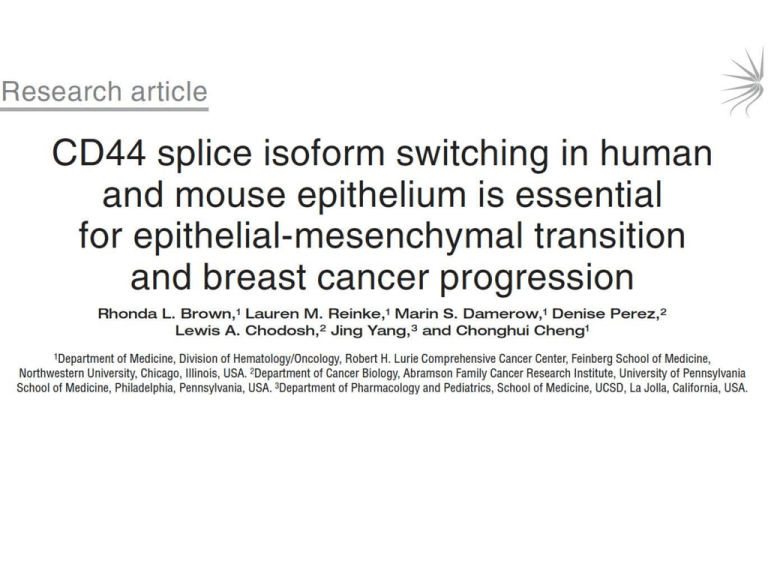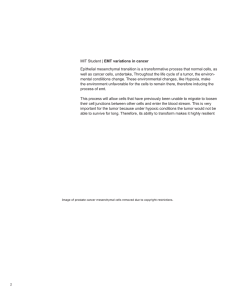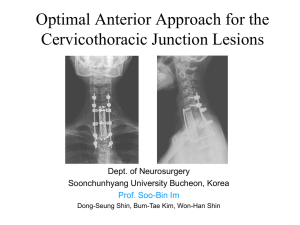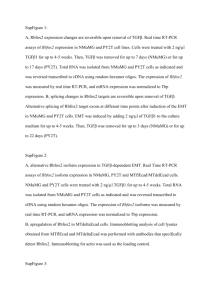and that CD44v - The Hynes Lab
advertisement

Regulated Splicing Changes are Associated with Tumor Type and Grade •Exon specific array from 3 lymphoma cell lines (IV, IVb and III) and non-tumor B cell line •Colors vary from blue to red with increasing signal intensity and from dark to bright with the confidence on the value observed in multiple measurements •Note the clustering of IV and IV samples Relogio et al, JCB 2004 Tumor Cell Switch from Pyruvate Kinase M1 isoform to M2 isoform Promotes Tumor Growth Stable knockdown of PKM2 in the human lung cancer cell line H1299, rescued with M1 or M2 isoform Christofk et al, Nature 2008 Tumor Cell Switch to Mena INV Isoform Promotes Metastasis Goswami et al, Clin. Exp. Met. 2009 Expression of the INV isoform of Mena promotes metastasis Invasive rat mammary adenocarcinoma line following SCID mouse mammary xenograft Philippar et al, Cancer Cell 2009 Global Analysis of Splicing Changes During EMT RNA-seq analysis of splicing changes induced in HMLE-TwistER by Tam treatment Shapiro et al Plos Genetics 2011 ESRP1 & ESRP2 are Key Regulators of Alternative Splicing During EMT •Pulled out by a cDNA screen of 15,000 genes in 293T cells with a luciferase reporter of FGFR2-IIIb (epithelial) expression (293T cells normally express mesenchymal FGFR2-IIIc) •Found that suppression of ESRP1 in PNT2 (human prostate cell line with epithelial expression profile) was sufficient to cause three characterized EMT splicing switches: - CD44v8-10 to CD44s (epithelial to mesenchymal) - Mena 11a exclusion (epithelial to mesenchymal) - p120-catenin exon 2&3 inclusion (epithelial to mesenchymal) Warzecha et al Mol. Cell. 2009 Knockdown of ESRP1 & ESRP2 Results in Mild Mesenchymal Phenotype Lentiviral shRNA Knockdown in human Mammary epithelial Cells (HMEC) Warzecha et al EMBO 2010 Alternative Splicing of CD44 Ponta et al, Nature Reviews 2003 •CD44 binds hyaluronan •Mediates cell signaling as a platform and as a co-receptor Reduced Inclusion of v6 in Some (but not all) Metastatic Cancers Anti-CD44 v6 Anti-CD44 costitutive benign cutaneous papilloma squamocellular carcinoma metastasis Salmi et al, JCB 1993 Switch from CD44v to CD44s with EMT in vitro A-C) HMLE/Twist-ER cells D) HMLE/Snail-ER cells (left), TGF-β (5 ng/ml) treatment in HMLE cells (middle), or Twist expression in MDCK cells Depletion of CD44 Inhibits EMT in vitro A-C) HMLE/Twist-ER cells before and after of tamoxifen treatment (14 days A&B, 12 days C) D&E) HMLE cells before and after 18 days of TGF-β treatment (5 ng/ml ) EMT Can Be Rescued by CD44s not CD44v B) HMLE/Twist-ER before (untreated) and after 12 days of TAM treatment C) IF for E-cadherin at 12 days D) MCF10A cells expressing CD44s or CD44v before and after 20 days of TGF-β (1 ng/ml) ESRP1 Promotes Inclusion of v Domains and Inhibits EMT A) HMLE/Twist-ER cells during TAM-induced EMT D) HMLE/Twist-ER cells before (untreated) and after 14 days of TAM treatment E) HMLE before (untreated) and after 14 days of TGF-β treatment CD44s (but not CD44v) Promotes Akt phosphorylation A) MCF10A cells (spontaneously immortalized human breast epithelial line). MCF10AM is the same line induced to mesenchymal phenotype by TGF-beta. pAkt in with insulin stimulation. B) E-cadherin expression was blocked by PI3K inhibitor LY-294002 C) Expression of CD44s, but not CD44v promoted pAkt D) Knockdown of CD44 inhibits insulin induced pAkt CD44s (but not CD44v) inhibits Apoptosis E) CD44s but not CD44v expression blocks apoptosis in MCF10A cells in response to DNA cross-linker or growth in suspension F) Apoptosis-block in MCF10A cells expressing CD44s is reduced by inhibition of PI3K (LY-294002) but not MEK (U0126) CD44v to CD44s Switch in Mesenchymal Mouse Tumor A-C) Expression of CD44 isoforms in MMTV-rtTA/TetO-NeuNT mouse model in primary tumor and recurrent HER2/Neu-independent mesenchymal tumors that develop in the primary site after turning off HER2/Neu over-expression. CD44 Knockdown Inhibits Growth of Mesenchymal Transplant Tumor in Mouse A-C) Knockdown of CD44 in recurrent tumor derived cells inhibits incidence and burden. (5 × 105) were injected into the mammary fat pad of female FVB mice, harvested at 3 weeks D) Limiting (500 cells) injection at 5 weeks. shCD44 cells expressed CD44s, but not CD44v E&F) CD44 knockdown increases apoptosis to UV or cisplatin in these cells in vitro CD44s (not CD44v) RNA Expression is Correlated with Tumor Grade and N-cadherin Expression in Clinical Samples •Both CD44v5/6 and CD44s were increase in tumor vs. normal tissue •CD44v5/6 was not significantly changed between tumor grade and did not correlate with N-cadherin Conclusions & New Questions •CD44v to s isoform switching occurs during EMT (known) and is functionally important in the Twist, Snail and TGFb induced EMT in human epithelial cells lines in vitro •Isoform switching is correlated with mesenchymal phenotype in mouse mammary tumor in vivo and in human clinical samples •Isoform switching is regulated in large part by ESRP1 (known) •CD44s variant protects against apoptosis through Akt/Pi3k •Is the EMT induced splicing switch conserved across tumor types? -Earlier work suggested that CD44v promotes metastasis (rat rat pancreatic adenocarcinoma model) and that CD44v (not CD44s) is upregulated in brain mets •What is the effect of the splicing switch on tumor metastasis? Metastasis is Impaired in CD44 null Mice Weber et al, Cancer Res. 2003 •Heterozygous p53 deficient mutants develop primary osteosarcomas •Analyzed liver and lungs (by serial sections) in 6 CD44+/+ and 4 CD44-/- mice











